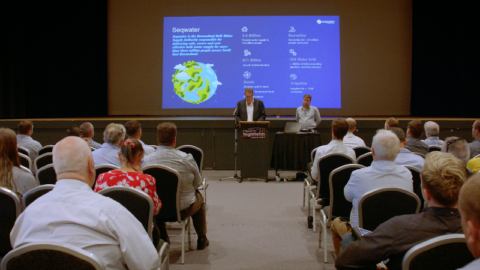Research conducted by the Australian National University (ANU) has identified around 5,000 potentially suitable pumped hydro storage sites in Queensland, Tasmania, the Canberra district, and in and around Alice Springs.
The Australian Renewable Energy Agency (ARENA) is providing $449,000 support for the ANU-led study, aiming to develop a nation-wide atlas of potential off-river pumped hydro storage sites.
Professor Andrew Blakers,the study’s lead researcher from the ANU Research School of Engineering, said the sites had storage potential ranging from 0.9 to more than 100 Gigawatt-hours (GWh).
“Each site has seven to 1,000 times larger storage potential than the 0.13 GWh Tesla battery to be installed in South Australia,” said Professor Blakers.
Professor Blakers said pumped hydro energy storage – which accounts for 97 per cent of energy storage worldwide – can be increased across the country to support high levels of renewable energy, primarily solar photovoltaics and wind.
He said the sites identified so far in the study have a combined energy storage potential of 15,000 GWh, which is 35 times larger than required to support a 100 per cent renewable electricity grid in Australia.
The ANU team has considered the possible benefits of using hydro power energy storage, where water is pumped uphill and stored to generate electricity on demand.
“Additionally, pumped hydro has a lifetime of 50 years compared with eight to 15 years for batteries.
“This assessment is based on very appealing physical characteristics. But the potential upper reservoir sites identified would require detailed due diligence involving land ownership, engineering, hydrological, environmental and other considerations.
“Further site searching is underway in NSW, Victoria, Western Australia and the Northern Territory, and will add greatly to this total,” Professor Blakers said.
Off-river pumped hydro storage requires pairs of reservoirs, typically ranging from 10 to 100 hectares, in hilly terrain and joined by a pipe with a pump and turbine. Water is circulated between the upper and lower reservoirs to store and generate power.
“All the potential sites we have found are outside national parks and urban areas, and like all hydro power can go from zero to full power very quickly,” Professor Blakers said.
The reservoirs are separated by an altitude difference of at least 300 metres.
The water would be stored in an upper reservoir and run through a turbine to a lower reservoir when electricity is needed – such as when the sun is not shining or the wind is not blowing. The water can then be pumped back uphill when electricity from renewables and other sources is abundant and cheaper.
Co-researcher Dr Matthew Stocks said pumped hydro storage, depending on the size of the reservoirs, would be capable of delivering maximum power from hours to more than a day.
“Our earlier work demonstrated the feasibility of 100 per cent renewable electricity for Australia supported by pumped hydro storage,” said Dr Stocks.
“About 3,600 hectares of reservoir is required to support a 100 per cent renewable energy grid for Australia, which is five parts per million of Australia’s land mass. Annual water requirements would be less than one per cent of annual extraction from the Murray River.”
Co-researcher Mr Bin Lu said pumped hydro and batteries were both likely to have prominent storage roles.
ARENA CEO, Ivor Frischknecht, said the project was part of ARENA’s focus on supporting flexible capacity solutions to ensure a smooth transition to a renewable energy future.
“Storage is becoming more important and valuable as we move towards higher levels of renewable energy in our grids,” Mr Frischknecht said.
“Pumped hydro is the most mature form of energy storage, and studies like these are helping to determine whether it could play an even greater role in increasing grid stability.”
ANU is partnering with ElectraNet and VTara Energy Group to conduct the Atlas of Pumped Hydro Energy Storage Study and develop a cost model for short-term off-river pumped hydro energy storage.














